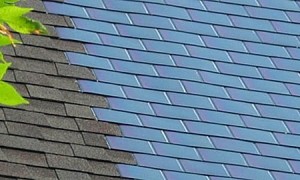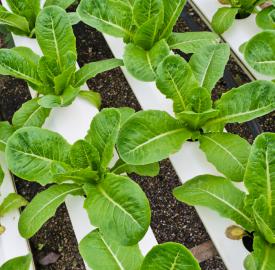Posted: February 17th, 2014 | Author: jimmurray | Filed under: Re-use, Recycled Wood, Trees & Parks | Tags: furniture, Recycled wood | No Comments »
Showcasing our massive international reach, this post come to us from the land down under and was sent by an innovative furniture company called Jarrimber, that makes a lot of its furniture out of recycled wood. The pieces they create are really quite beautiful as well as thoughtfully designed and crafted. You can check them out at http://www.jarrimber.com.au/

Posted: February 6th, 2014 | Author: jimmurray | Filed under: Green Businesses, Green Recycling, Solar Energy, Solar Roofing Shingles, Sustainable Architecture | Tags: Solar Roofing Shingles, Yale Environment 360 blog | No Comments »
 The wonderful thing about real innovation in green technology is how simple they are. This short article about the development of solar energy roof shingles is a great example of what I mean here. Normally creation of solar energy generating panels requires the uses of rare earth metals which are becoming, rarer as time goes by. So the need to create new energy saving ideas from materials that are cheaper and more abundant is the next big frontier.
The wonderful thing about real innovation in green technology is how simple they are. This short article about the development of solar energy roof shingles is a great example of what I mean here. Normally creation of solar energy generating panels requires the uses of rare earth metals which are becoming, rarer as time goes by. So the need to create new energy saving ideas from materials that are cheaper and more abundant is the next big frontier.
This article was posted on the Yale Environment 360 blog. We encourage you to check it out, and subscribe to this blog. This is a big green idea and those are always the best kind.
http://e360.yale.edu/digest/solar_shingles_made_from__common_metals_offer_cheaper_energy_option/3600/
Posted: January 19th, 2014 | Author: jimmurray | Filed under: Green Home, Our Green Directory | Tags: cleaning with vinegar, Ecofriendly cleaning, green cleaning | No Comments »
Guest post from Christine Maddox.
We have a complete open door policy for guest blogs. If you have an idea for a blog, please email it to me, and if it fits our criteria, I will send you a complete submission guide. We post one blog per week, more or less. jim.murray@ourgreendirectory.com
*****************
 Cleaning in an eco-friendly way can be both easy and inexpensive. One of the best eco-friendly cleaners is plain white vinegar. White vinegar acts as an antibacterial agent, removes bad smells, and helps to shine a variety of surfaces. It is safe to use on almost anything and around children and pets. Here are ten ways you can clean with vinegar:
Cleaning in an eco-friendly way can be both easy and inexpensive. One of the best eco-friendly cleaners is plain white vinegar. White vinegar acts as an antibacterial agent, removes bad smells, and helps to shine a variety of surfaces. It is safe to use on almost anything and around children and pets. Here are ten ways you can clean with vinegar:
- Get stains off linoleum with vinegar. Apply vinegar directly to the stain and let it sit for ten to fifteen minutes. If stain is still there apply the vinegar again and then sprinkle with baking soda. Scrub the stain with a brush or cloth until it is removed and then rinse it clean.
- Shine no-wax floors with vinegar. Just add a cup to a gallon of warm water and wash the floors for a clean, fresh smelling shine.
- Clean the toilet with vinegar. Pour in a cup or more to the toilet bowl and let it sit for several hours or overnight. Scrub well and then flush for a white and scent free toilet.
- Clean and open up a scummy or clogged shower head with vinegar. In a sandwich bag mix half a cup of baking soda with a cup of vinegar. Tie the bubbling bag over the shower head and let it sit for at least an hour after it stops bubbling. Then remove and run the water for a few minutes to clean out any residue.
- Clean shower door or sliding door tracks with vinegar. Pour in white vinegar and let it sit for a few minutes. Then rinse with hot water and scrub with a toothbrush to remove any lingering build up.
- Sanitize a sponge or loofa with vinegar. Let the sponge or loofa sit submerged in undiluted vinegar overnight. Then rinse well and squeeze out the moisture. Let it sit in the sun until dry and it should be germ, mildew, and scent free.
- Clean the ring or film from your bathtub with vinegar and baking soda. Rinse out the tub with the vinegar and let it sit several minutes. Then scrub with a baking soda paste and rinse with warm water for a sparkling tub. This also works great on grout and tile!
- Keep shower doors clean by spraying them with vinegar each time you get out of the shower. This will help to break down hard water stains and prevent soap build up.
- Remove lime, calcium, and soap deposits with vinegar. Tie a bag of undiluted vinegar around lime coated faucets and let it sit for several hours. Then remove and rinse off.
- Remove grease wherever it gathers with a vinegar spray. Just spray on and let it sit for a few minutes and then wipe off the grease.
ABOUT THE AUTHOR: This post is contributed by Christine Maddox. Currently she is pursuing her Master’s degree from University of Texas as well as blogging for www.4nannies.com. She loves to write anything related to parenting, kids, nanny care etc. She can be reached via email at: christine.4nannies@gmail.com.
Posted: January 12th, 2014 | Author: jimmurray | Filed under: Energy Conservation, Green Recycling, plastic recycling | Tags: metal recycling, metal waste management, recycling, waste management solutions | No Comments »
This post comes to us from the lovely and talented Christine Maddox from www.4nannies.com.
We have a complete open door policy for guest blogs. If you have an idea for a blog, please email it to me, and if it fits our criteria, I will send you a complete submission guide. We post one blog per week, more or less. jim.murray@ourgreendirectory.com
*********************
There has been a huge focus on recycling in recent years as people across the world attempt to cut down on the negative impact they can have on the environment. As well as individuals doing their bit, businesses and entire nations are getting involved; coming together to make a difference. With this in mind, are we doing enough to hit recycling targets, or does more need to be done?
Why bother?
There are some people who don’t think there is any point in recycling anything and just throw everything away. However, if you are one of these people, take a moment to consider the impact this actually has. You may find that you want to start recycling some of your items. Landfill sites are filling up rapidly and space is running out for all the rubbish. Nobody wants to be living next to a giant rubbish site, but if the amount of waste keeps building, this is a very real possibility for the future.
A lot of the items that end up in landfill sites can easily be recycled, effectively taking up less room and making space for things that can simply rot into the ground. Plastic bags from supermarkets take years to break down but can easily be reused for your shopping several times over. Some shops have started giving incentives to people who reuse their old shopping bags, while others have started charging for plastic bags in a bid to crack down on the amount of waste these create.
Bigger scale
The amount of waste being created across the world can impact us in a bigger way as well. Many people are concerned about the effects of global warming and the greenhouse effect so governments in various different nations have implemented recycling targets. Wales was recently shown to be on track to meet its recycling target, having a long-term goal of zero waste by 2050. While that might seem like an unachievable goal, they are already hitting over 50 per cent of that target.
If all the countries in the world took a similar stance to recycling, the effects it has on the environment could be drastically reduced. From the point of view of a business, recycling might not be a top priority but it should be. There are various companies that are dedicated to waste disposal and recycling so it would be wise for businesses to recruit these services if necessary. If the nature of the business means that lots of waste is being created but it is not practical for them to recycle or reuse any of it, an external company could sort this out for them.
It’s easy to think that the little things don’t make much difference but if everyone started recycling on an individual scale, the overall results would be breath-taking. Even in a small office, doing as something as simple as putting the empty milk cartoons into the recycling bin can do its bit towards saving the environment and cutting down on the carbon footprint left on this earth. Of course as a business there are professional providers of business recycling including http://www.bettsenvirometal.com/.
Posted: December 31st, 2013 | Author: jimmurray | Filed under: Green Products, Sustainable Architecture, Trees & Parks | Tags: carpentry, construction, eco-friendly wood, joinery, materials, timber, Woodwork | No Comments »
This post comes to us courtesy of a British company called Inwood. This is a company that makes wooden entrance gates and garage doors and from the look of their site, they are very good at it. These people work with wood and make beautiful things from it. But they are also quite sensitive to the sustainable aspects of wood growing and harvesting. I found this article to be quite interesting, and I hope you do too.
Also, since this is the last post of the year, Terry, Simon and I would like to wish you all the best in 2014.
*******************

Timber is obviously one of the planet’s most vital resources, a useful building and crafting material that’s both practical and hard wearing. However it is vitally important to make a conscious effort to maintain forest-land due to its obvious importance in helping climate, biodiversity, and critical eco-systems.
When sourcing timber there are a few key areas to consider in determining whether it is eco friendly:
- Is the wood legally sourced from non-ancient or non-protected forests?
- Is the wood certified by the Forest Stewardship Council (FSC)?
- Is the wood certified by other organizations? (“SmartWood by Rainforest Alliance”, “Green Seal” etc)
- How durable is the wood?
- How long does it take to reach maturity? (the less time, the more easily-managed the source is)
The last two points are the key to what is known as the felling/replanting balance, it is vital for the source to be planted and grow to maturity at a faster rate than it is felled. This is the fundamental key to eco-friendly timber.
We make a sustained effort to meet all these criteria that goes hand-in-hand with the type of quality we’re looking to deliver with our wooden garage doors at Inwood. Here are the some types of sustainable wood and wood alternatives that we either use or are aware of:
Bamboo:
Strictly a wood plant rather than timber itself, and originally regarded as a poor mans material, bamboo provides a surprisingly useful wood alternative. It is incredibly strong (used as reinforcements in Asia) but also very light, making it a perfect commodity for fencing, furniture, and flooring.
The positive about bamboo and its staggering 1500 different species is that, apart from a few of the species, it is vastly less threatened than any timber source. Although vital for housing and as a food source for giant pandas and mountain gorillas, bamboo grows incredibly fast so it is easier to sensibly maintain and meet the growing demands of the wood industry.
By using bamboo you can almost safely say that you are buying from a well-managed source, and in doing so taking much needed strain off other vital timber sources.
Accoya:
Here at Inwood we are proud to use Accoya wood (which comes from a softwood), we find it the best suited eco-wood in our production of gates and garage doors. Softwood reaches maturity faster than hardwood, but annoyingly it also lasts for a considerably less time.
For example Scandinavian Redwood (softwood) lasts for around 10 years but grows to maturity in 25 years, but Oak (hardwood) takes up to 60 years to grow but lasts for at least 30 years.
This makes it incredibly hard to judge weather softwood or hardwood is the most eco-friendly. However, Accoya cracks this conundrum, it’s a softwood that has been scientifically modified to greatly enhance its strength and durability.
Accoya ticks many boxes it is long lasting and fast growing, helping to maintain the felling/replanting balance which many other wood sources have tipped the wrong way, leading to mass deforestation.
Pine:
Many original pine forests have been ravished, but as a consequence it is now, in the UK, almost exclusively cultivated from sustainable plantations managed and certified by the FSC. Due to the dwindling number of ancient pine forests pine should not be sourced from places without an FSC label (countries such as Finland Latvia, Estonia and Russia being rife for illegal logging).
However in most of the other northern hemisphere countries pine forests and plantations are extremely well maintained (probably the best out of the major commercially important woods). This means in the main that the all-important balance between felling and replanting is being met, making pine one of the best commercial woods of choice.
About Inwood:
Inwood is a UK-based bespoke joinery company specializing in wooden garage doors, currently enjoying giving away free offcuts to local schools!
Wooden garage doors at Inwood = http://www.woodworkersuk.co.uk/wooden-garage-doors.htm
Accoya wood = http://www.accoya.com/
Posted: December 10th, 2013 | Author: jimmurray | Filed under: Energy Conservation, green art, Trees & Parks | Tags: 2014 Calendar. trees, 2014 Toronto Tree Portraits Calendar, conservation, greenspace, parks | No Comments »
 Nothing says green like a tree, or so the saying goes. This morning I received this email from the Toronto Trees & Parks Foundation. I’d never really heard of them before, but evidently they do a lot of good things in the green spaces of the city. As part of their marketing they create and sell a calendar of tree portraits. Here’s the email they sent me:
Nothing says green like a tree, or so the saying goes. This morning I received this email from the Toronto Trees & Parks Foundation. I’d never really heard of them before, but evidently they do a lot of good things in the green spaces of the city. As part of their marketing they create and sell a calendar of tree portraits. Here’s the email they sent me:
The Toronto Tree Portraits 2014 Calendar showcases the unusually creative photographs by veteran artist Gerald Dillon, whose work features bird’s eye-views, close-ups, and bold vistas. This is the third time that esteemed author and advocate Lorraine Johnson has written the texts for the Toronto Tree Portraits Calendar. It also features a wonderful forward by photographer and writer, Vincenzo Pietropaolo.
 This year’s calendar marks the 10th anniversary of this much-loved publication! Help celebrate the natural heritage of our city and support the work of the Foundation with every purchase!
This year’s calendar marks the 10th anniversary of this much-loved publication! Help celebrate the natural heritage of our city and support the work of the Foundation with every purchase!
Similar to previous years, the 2014 Toronto Tree Portraits Calendar is conveniently formatted as a self-standing desk calendar. It is square, measuring 7″ wide by 7″ tall. All proceeds from sale of the Calendar go directly towards preserving, enhancing and increasing Toronto’s urban forest. The Toronto Parks and Trees Foundation is a non-profit, charitable organization that works with the City of Toronto and community groups to enhance and preserve Toronto’s parks and urban forest.
The 2014 Toronto Tree Portraits is available on-line for: $23.75 including HST and shipping.
This could make a great little holiday gift. If you want to check them out, you can do that at https://torontoparksandtrees.org/
Posted: December 1st, 2013 | Author: jimmurray | Filed under: Energy Conservation, environmental challenges, Green Technology, Sustainable Architecture | No Comments »

This link comes from OGD friend Scarlett Jackson. It’s posted on a rather interesting blog called Best MSW Programs which is a guide finding the best Masters of Social Work programs. Social work in an of itself is related to sustainable practices, in that, for example, a number of new social housing projects are being built to high LEEDS standards. As the intro to this post states:
“As populations grow and cities become more crowded than ever, public housing has become an increasingly important issue for governments around the world. However, social housing is no longer limited to characterless blocks of concrete. These days, the aim is often to provide low-cost housing to individuals and families who need it – while still affording them the dignity of well-designed and distinctive homes.
These modern public housing projects frequently incorporate eco-conscious designs and elements, as efficient energy usage tends to be a priority. Here we look at 30 of the world’s social housing developments that break the mold, undoing negative stereotypes and serving as remarkable works of architecture in their own right.”
This is a fascinating look at how the world of public housing design and construction is helping to relieve the energy consumption burden of those whose taxes support these developments, while also making public housing more attractive and liveable for residents.
Check it out. It makes for some fascinating reading: http://www.bestmswprograms.com/impressive-social-housing-projects/.
Image source: http://www.koz.fr/indexhibit/index.php/project/lastrolarbre/
Posted: November 25th, 2013 | Author: jimmurray | Filed under: Energy Conservation, environmental challenges, Green Businesses, Green Home, Green Technology | Tags: conservation, heating system filters, insultaton, Tags: Green, winter | No Comments »
This is a guest post by Ken Myers. Thanks Ken.
 Air conditioning in the summer can easily drive the electric bill to high levels. However, winter can easily surpass the energy used to keep yourself warm. Unlike the summer, the cold of winter can be relentless and has fewer ways you can adapt. If you want a method to determine how efficient your energy use is, the winter months are where you could set the bar.
Air conditioning in the summer can easily drive the electric bill to high levels. However, winter can easily surpass the energy used to keep yourself warm. Unlike the summer, the cold of winter can be relentless and has fewer ways you can adapt. If you want a method to determine how efficient your energy use is, the winter months are where you could set the bar.
Gas and Electricity Used in Conjunction
In order to produce cold air during the summer, homes and offices will utilize pure electricity to drive appliances. While some homes may rely on a completely electrical heating system for the winter, many more rely on burning gas for heat and then electricity to divert the warm air to various locations around the establishment. In this instance, gas and electricity are used as an energy source to provide that warmth.
Preventing Heat from Escaping
During the winter, the heat can escape the home or office through various means. This could include everything from windows to even the walls themselves. Insulation doesn’t just keep the cold air out, but it’s supposed to help keep the warm air in. What are some items to look at in your home or office?
- Windows: Having double-paned windows is a good way to keep more of the heat in and cold out. If you’re unable to install such, covering the windows with cardboard or other covering can help keep heat in. When the Sun is shining, open these coverings to allow the sunlight to heat up your home or office.
- Doors: Not having a proper seal around your door frames can easily cause problems for efficiency. Cold air can enter while warm air exits. Make sure you have a tight seal on your doors using self-adhesive weather stripping and properly fitted door jams and thresholds.
- Inadequate Insulation: Not having proper insulation can also be detrimental. If you are unable to check how well your insulation covers your walls and ceiling, there are radiant thermal barrier paint additives you can coat them with to add an additional layer of insulation.
Filters
Keeping the filters clean on your heating system is another way to increase your efficiency that many people overlook. When dust collects onto the filters, it restricts the flow of air that furnaces use to heat the area of a room or office space. Without this airflow, the heating system will continue to waste resources in an attempt to increase the temperature of the room according to the thermostat. A clean filter will allow the air to pass through allowing the system to work as intended and heat the facility or house quicker.
Winter can be extremely harsh on both you and your pocketbook. By going around your home or office, you can easily tell where weak areas are for heating efficiency from feeling the temperature. For rooms that are not used that often, keep the door closed in order to reduce the need for heat. If these rooms are near your thermostat, they could cause your heater to kick on even if no one is using them.
Author Bio:
Ken holds a master’s in business leadership from Upper Iowa University and multiple bachelor degrees from Grand View College. As president of morningsidenannies.com, Ken’s focus is helping Houston-based parents find the right childcare provider for their family. When he isn’t working, he enjoys spending time with his three children and his wife.
Guest Bloggers Welcome
If you have an idea for a green blog post, email me at jim.murray@ourgreendirectory.com and I will send you the submission critieria.
Posted: November 18th, 2013 | Author: jimmurray | Filed under: Aquaponics, Green Businesses, Green Initiatives, Green Technology, Our Green Directory | Tags: aquaponics, eco system, nitrates, plants | No Comments »
This is a guest post from blogger, bAmanda Kostina.
 Aquaponics is the combination of aquaculture and hydroponics. The former concerns the raising of aquatic animals, while the later deals with growing plants or vegetables in water. By combining the two, aquaponics creates a mutually beneficial system where water and nutrients are recycled naturally. By feeding the waste water from an aquaculture system into a hydroponics system, essential nitrates and nitrites are created in a natural way. This leaves a clean, healthy environment for the fish, while providing nutrients for the plants. In this list, you will find ten more excellent reasons why you should consider a aquaponics system.
Aquaponics is the combination of aquaculture and hydroponics. The former concerns the raising of aquatic animals, while the later deals with growing plants or vegetables in water. By combining the two, aquaponics creates a mutually beneficial system where water and nutrients are recycled naturally. By feeding the waste water from an aquaculture system into a hydroponics system, essential nitrates and nitrites are created in a natural way. This leaves a clean, healthy environment for the fish, while providing nutrients for the plants. In this list, you will find ten more excellent reasons why you should consider a aquaponics system.
- Weeding – With aquaponics, it’s simply not an issue. The systems don’t use soil or any processes that enable weeds. Without weeds, you can concentrate on growing vegetables and watching your fish grow. That means that you can say goodbye to that lower back-pain from constantly having to bend down to pull out weeds.
- Reduced Space – In aquaponics systems, plants and vegetables are constantly fed through water and nutrients. This means that the footprint needed is significantly less than with traditional crop farming. As long as each plant is getting enough light, you can effectively grow plants in much closer quarters.
- Artificial fertilizer – Forget about ever having to buy artificial fertilizer once you set up an aquaponic system. The only additional food that your plants will need is supplements to balance nutritional intake. However, not all systems will require an additional supplement, which means 100% savings on fertilizers. Most important of all is the fact that you can’t actual add fertilizer to the system, as it will kill any fish you have in the tank.
- Faster Plant Growth – With a constant feed of essential nitrates, plants grow much faster in aquaponics systems. The level of output is also affected by the reduction in space, allowing the system to produce higher yields than traditional soil planting. Also, aquaponics systems are improving all the time, which can only mean that even faster plant growth will be possible in the future.
- Water Reduction – All water in aquaponics systems is recycled. This means that your overall water usage will greatly reduced, which is good for both the environment and your pocket. There is little to no labor involved in the process, either. Apart from occasional top-ups and cleaning pumps and filters, you won’t have to lift a finger to maintain optimum water levels.
- Organic Systems – Provided that you give your fish stock only organic feed, an aquaponics system is completely eco-friendly. You will benefit from only the most natural crops and plants, while your fish are fed on healthy organic products, too. This is a win-win for humans, plants and fish. You can’t always guarantee that store bought vegetables are organic, but you can with your own aquaponics system.
- Sustainability – As your aquaponics system is effectively a self-sustaining ecosystem, you don’t have to worry about eroding resources. Once you determine the best level of production, you can maintain growth and output at a constant level. Soil systems, on the other hand, drain their ecosystem of resources, requiring you to constantly re-balance nutrients and the soil’s health.
- No Pesticides – With soil, you have to use pesticides to prevent plants from becoming damaged or destroyed. As aquaponics does not use soil, related pests are automatically out of the picture. What’s more, your plants won’t be absorbing any toxins from pesticides, making for a much healthier crop.
- Dollar Output – If you sell your crops, the increased yields from aquaponics will also increase your bottom line. With the huge demand for organic produce, you will find that your customer base will grow, too. Don’t forget that you also have fish stock, which means aquaponics potentially provides a dual revenue stream.
- Labor Reduction – Less labor for you, less use of energy, and less time spent working in your garden in general. After you install your aquaponics system, you will notice a significant drop in the amount of time you spend slaving over gardening related tasks. This gives you more time to enjoy your garden, while still being able to reap all the rewards.
So there you have it – ten ways that you can benefit from owning an aquaponics system. Reduced labor, higher yields, healthier animals and plants, and more money in your pocket. With so many positives, you really have nothing to lose. Plus, with an aquaponics system, you always have the best of two worlds.
Resources:
http://en.wikipedia.org/wiki/Aquaponics
http://www.backyardaquaponics.com
More good green articles can be founds at http://savings.whitefence.com
Posted: October 26th, 2013 | Author: jimmurray | Filed under: Green Businesses, Green Recycling | Tags: business, green, Green Movement, saving money, Sustainability | No Comments »
This is a guest post from blogger and friend of Our Green Directory, Elizabeth Reed. We have an open door policy for guest blogger. As long as it’s green, interesting and informative we’re happy to post.
 No one goes into business to lose money on purpose. As we live in the digital age, there are many ways we can save money around the office while improving efficiency. Practicing “greener” ways of doing business can keep more money available for the things you need. This doesn’t mean you need to sign up with Green Peace or other organizations, but you may need to change your point of view in order to implement some of these ideas.
No one goes into business to lose money on purpose. As we live in the digital age, there are many ways we can save money around the office while improving efficiency. Practicing “greener” ways of doing business can keep more money available for the things you need. This doesn’t mean you need to sign up with Green Peace or other organizations, but you may need to change your point of view in order to implement some of these ideas.
1. Conversion to Paperless – Much of what we do in today’s world is paperless as it is. Using email, you can eliminate a great deal of the paper that your business goes through. How far can you take a paperless system?
- Accounting software that uses email to send invoices and transactions
- Time card systems for employees that are based on a computer system
- Emphasize email for sending memos throughout your organization
- Payment acceptance systems that email receipts instead of printing them
These are just a few implementations you can enact that could save your business money in both paper and ink. Each one can also be considered more efficient in its own right due to the fact that man-hours are no longer needed to maintain them.
2. Computer Systems – Although new computers are being built to be more energy efficient than those of old, powering down these devices at night can save money on your energy bills. This is aside from the wear and tear internal moving components experience as they sit idle. For instance, most cooling fans have a life of 50,000 hours. Once these breakdown, the computer system can easily overheat and cause additional and more expensive damage to repair.
3. Lighting – Motion detection or timed light switches can prevent the occasional “accident” of leaving the lights on in a room. Many businesses have moved to installing motion detecting switches in the bathrooms and break rooms in order to reduce the energy waste. It makes no sense to leave lights on in an area if no one is there to use them. While it may only be one room, the energy wasted throughout the year can easily add up. Timed light switches are common in areas such as storage units where motion is common in the outdoors. As a cat or dog could set off a motion light, a timed switch will turn itself off until a patron needs to access a unit.
There are many ways that a business can save money by practicing greener methods. In fact, some have even gone so far as to make money by recycling specific products. Regardless of your company’s focus, green innovation allows you to find a better approach to operations that save money. Not only can you do your part in protecting the environment you live in, but you can protect your company’s assets while doing so.
Author Bio:
Elizabeth Reed is a freelance writer and a resident blogger at Liveinnanny.org. She particularly enjoys writing about parenting, childcare, health and wellness. In addition, she is an expert consultant on issues related to household management and kids.









